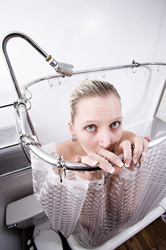Cancer-Causing Disinfection Byproducts: Are You Aware of These Toxins That Contaminate Virtually ALL U.S. Water Supplies?
by www.SixWise.com
Disinfection byproducts (DBPs) are created when the disinfectants used to kill bacteria in the U.S. drinking water supply react with natural organic matter, such as decaying vegetation, or when certain compounds such as bromide are present in the water.

Disinfection byproducts are lurking in your water … and you likely absorb more of them when showering than you do by drinking the water! |
As chlorine is one of the most widely used forms of disinfection in the United States, chlorination byproducts are among the most concerning disinfection byproducts contaminating the water supply. Among them are:
- Trihalomethanes (THMs): These include chloroform, bromoform, bromodichloromethane and dibromochloromethane. The maximum annual average of THMs detected in local water supplies cannot exceed 80 ppb per Environmental Protection Agency (EPA) regulations.
Studies have linked THMs with low birth weight and neurological abnormalities in infants, along with increased incidences of neural tube defects, small body length, and small head size in babies born to women drinking water containing 400 ppb THMs. Research has also linked an increased risk of bladder cancer with exposures of 50 ppb, and first trimester miscarriage in pregnant women drinking water with 75 ppb -- both of which are under the EPA “safe” limit.
Levels of THMs between 80 and 100 ppb and above are associated with increased incidences of neural tube, central nervous system, and major cardiac birth defects.
- Haloacetic acids (HAAs): These include monochloroacetic acid, dichloroacetic acid, trichloroacetic acid, monobromoacetic acid and dibromoacetic acid. The maximum annual average of HAAs permitted by EPA regulations is 60 ppb.
Classified by the EPA as possibly carcinogenic to humans because of evidence of carcinogenicity in animals, studies have linked HAAs with an increased risk of cancer, and injury to the brain, nerves, liver, kidneys, eyes and reproductive systems.
Further, the Environmental Working Group (EWG) points out that evidence has shown exposure to HAA during the second and third trimesters of pregnancy may be linked to intrauterine growth retardation and low birth weight. Certain HAAs have also been linked to a disturbance in the balance of the intestinal tract, which could increase the risk of pathogenic bacteria causing illness, particularly in those with compromised immune systems. They have also been shown to be toxic to the sperm of rats at concentrations as low as 10 parts per billion, and to cause a range of neurological effects.
While there are a total of 600 disinfection byproducts that have been identified by EPA scientists, legal limits for levels in tap water have been set for only 11 of them.
What is also concerning, as pointed out by EWG, is that legal limits, or MCL (Maximum Contaminant Level), for these toxins are “established as a balance between health, treatment cost and feasibility.” They are not, therefore, intended to be a true safe level of exposure.
How are You Exposed to Disinfection Byproducts? And What Can You Do?
There are two routes of exposure to DBPs: drinking chlorinated tap water and through showering, bathing or swimming in chlorinated water.
Studies show that showers and baths may contribute more to your total exposure to THMs and other disinfection byproducts than drinking water. When you shower or take a bath, the warm water opens up your skin's pores, making it like a sponge for chlorine, and you also absorb the chemicals when you breathe in the steam from the shower.
In fact, the steam from your shower can contain up to 100 times the chemicals as the tap water itself.
What we found most concerning was that almost none of the shower filters on the market reduce chlorine from shower water (nor drinking water).
This is a big concern, especially for expecting mothers, babies and children.
After exhaustive research we found only one filter that has the necessary true quality features that effectively remove nearly all chlorine.
Shower in the Luxury of PURE Healthy Water

The Wellness Shower effectively reduces up to 99% of chlorine for 24 months AND increases hydration of your skin and hair by 115 percent.
You'll notice the difference in your skin and hair after just one bath or shower. Plus, you won’t be exposed to dangerous DBPs.
Order The Wellness Shower Filter Now! |
Meanwhile, when you drink chlorinated water some of these toxins get filtered by your kidneys, liver and digestive system. This is not so when you breathe in these chemical vapors; there is no filtering, just a direct route to your bloodstream.
Take, for example, a study published in a 2007 issue of the American Journal of Epidemiology. The study participants who drank chlorinated water had a 35 percent increased risk of bladder cancer. However, those who spent time swimming in chlorinated pools had a 57 percent increased risk, and those who took long showers or baths also had an increased risk of bladder cancer.
According to some estimates, by taking a hot shower you end up absorbing over 600 percent more chlorine and other chemicals than you would from drinking the same un-filtered water all day!
Reaching a New Level of Pure Water
Given the serious health risks surrounding DBPs, EWG recommends filtering not only your home’s drinking water, but also the water you shower or bathe with.
Fortunately, this is a simple step to take and one that can reduce your, and your family’s, toxic load significantly.
The two options that Sixwise.com highly recommend come from Wellness, which produces both The Wellness Shower Filter and The Wellness Kitchen Water Filter.
The Wellness Kitchen combines the best filtration and enhancement technologies to deliver the purest and most natural tasting water available. It effectively reduces harmful contaminants, including chlorine and THMs, while at the same time enhancing the water with adding important yet delicate wellness "ions and minerals" that your body needs.
Meanwhile, The Wellness Shower effectively reduces up to 99 percent of chlorine from your shower's water for up to 24 months, which is two or three times longer than any other shower filtration system available.
The Wellness Shower prevents exposure to DBPs by removing chlorine before it reacts with your body, thereby reducing the likelihood that DBPs will form in the first place. But that's not all.
The Wellness Filter concept was developed in the 1980s by Harusuke Naito, a renowned Japanese sports physiologist and Olympic swimming coach who wanted to produce "perfect water" for his professional athletic clients.
Haru believed that even subtle differences in water purity, surface tension and mineral content could affect body hydration, cellular function, and athletic performance. After extensive field research and study he began experimenting with various natural filtering media in an effort to produce the world's best water.
The Wellness Filter is now widely known for its ability to enhance water beyond the reach of conventional water purification systems.
At the heart of its enhancement ability is an array of permanent, exotic media that until recently have not been seen outside of Japan. After the water is purified, these media induce into the water a unique combination of water-soluble trace minerals and ions that Japanese researchers believe aid the body's biochemical functions and cellular health.
In addition, the filter also contains a special far-infrared emitting ceramic media, which imparts reduced ions into the water. These ions provide a mild antioxidant effect in the body when consumed and on the skin when bathing. This aids your body in neutralizing free radicals, which are believed to be a primary factor in aging and in the development of cancer.
You owe it to yourself, and your family, to shower in, and drink, only pure water. To find out more about the Wellness Kitchen Filter and Shower Filter, you can visit their site now.
How to Find Out Levels of DBPs in Your Area
In 1998 a federal mandate was passed requiring all U.S. water utilities to prepare annual water quality reports, also known as Consumer Confidence Reports. These reports allow you to track the amount of disinfection byproducts and other contaminants in your drinking water supply. Contact your local water utility to find out when your next annual report will be released, or to review past versions.
And no matter where you live, you can always send a sample of your water to a qualified laboratory to be tested for contaminants. Either way, knowing exactly what’s in your water, and then taking the steps to make it as pure as possible, will give you peace of mind that your family’s water is healthy and safe.
Recommended Reading
Five Things to be Cautious of Regarding Your Tap Water and the Safer Alternatives
Four Common but Toxic Chemicals to Avoid During Pregnancy, Pre-Pregnancy and Breastfeeding
Sources
NSF.org
Environmental Working Group
American Journal of Epidemiology 2007 165(2):148-156